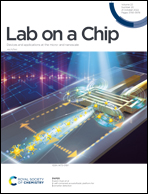Influence of microchannel geometry on device performance and electrophysiological recording fidelity during long-term studies of connected neural populations†
Abstract
Compartmentalized microfluidic neural cell culture platforms, which physically separate axons from the neural soma using a series of microchannels, have been used for studying a wide range of pathological conditions and basic neuroscience questions. While each study has different experimental needs, the fundamental design of these devices has largely remained unchanged and a systematic study to establish long-term neural cultures in this format is lacking. Here, we investigate the influence of microchannel geometry and cell seeding density on device performance particularly in the context of long-term studies of synaptically-connected, yet fluidically-isolated neural populations of neurons and glia. Of the different experimental parameters, the microchannel height was the principal determinant of device performance, where the other parameters offer additional degrees of freedom in customizing such devices for specific applications. We condense the effects of these parameters into design rules and demonstrate their utility in engineering a microfluidic neural culture platform with integrated microelectrode arrays. The engineered device successfully recorded from primary rat cortical cells for 59 days in vitro with more than on order of magnitude enhancement in signal-to-noise ratio in the microchannels.



 Please wait while we load your content...
Please wait while we load your content...
